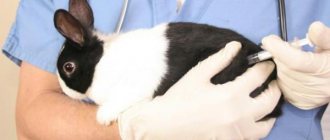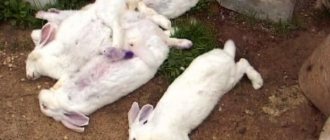» About rabbit breeding » Medicines for rabbits » Vaccine against VGBV and Myxomatosis - instructions
Myxomatosis and VGBV (viral hemorrhagic disease of rabbits) are dangerous diseases that are difficult to treat and often lead to the death of animals.
The main means aimed at combating these diseases are preventive vaccinations. For this purpose, an associated vaccine against myxomatosis and VGBV is used. It is a complex drug that, unlike other vaccines, provides protection against both diseases at once. The associated vaccine is produced from the B-87 strain of the VGBV and the B-82 strain of the myxoma virus. The dry porous mass is packaged in bottles with a capacity of 10-20 cm3, designed for 5-120 immunizing doses. When administered intradermally, subcutaneously and intramuscularly, the vaccine does not harm the health of rabbits. As a result of its use, intense immunity is formed on the third day after vaccination; its minimum duration is 12 months.
You need to know that only healthy animals can be vaccinated. In addition, veterinarians advise removing worms before administering the vaccine. When the drug enters the body of a sick rabbit, the animal may die.
When to vaccinate rabbits?
Rabbits are vaccinated for the first time when they are 45 days old, and the weight of the animals must be at least 500 grams. Vaccination is used in farms that are free, threatened and unfavorable for Myxomatosis and VGBV. In safe and threatened farms, immunization is carried out once, revaccination is carried out every 9 months. Rabbits are vaccinated at any time during pregnancy. In disadvantaged farms, healthy animals and 1.5 month old rabbits are vaccinated. 3 months after the first administration of the drug, revaccination of young animals is carried out, all subsequent vaccinations - every six months.
Use of associated vaccine in rabbits
The use of an associated vaccine for rabbits is advisable to prevent VGBV and myxomatosis, and not to treat them if they are already present in animals. The administered drug contains:
- active but weakened myxoma antigens;
- inactive (killed) pathogens of headache.
The associated vaccine is domestic, produced in the Vladimir region by the Federal State Budgetary Institution Federal Research Center for Vital Medicine.
Read our article on how to use Ivermek for rabbits.
Form and components
The association vaccine for rabbits contains antigens to myxoma in the form of a primary (FEC) or digested cell culture (RK-13) infected with pathogens of the B-82 strain. The second component is a suspension of animal livers infected with the pathogen VGBV, which is killed with formaldehyde or a similar substance.
The vaccine for rabbits is available in the form of a lyophilisate. Has a cream or pink tint. Easily diluted in solution for injection. A single dose of vaccine for rabbits contains 500 ID/50 myxoma and 32 GAE GB.
Whether or not to vaccinate rabbits is up to the owner to decide for himself. However, when choosing, it should be taken into account that these animals have very weak immunity; if one individual gets sick, it is almost impossible to avoid infecting the others. Myxomatosis and viral hemorrhagic disease of rabbits cannot be treated and cause the death of the entire farm. Getting a vaccine will help prevent this.
At what age to put
Associated vaccination for rabbits according to the instructions can be used at the age of 45 days, i.e. when the young animals are 1.5 months old. The weight of the individual must be at least 500 g. Before vaccination, you must make sure that the animal is absolutely healthy. If this is not taken into account, the vaccine will kill him within a short time.
How to dilute the vaccine (dosage)?
It is advisable that the vaccination be administered by a veterinarian, but if this is not possible, you can administer the drug yourself. Before use, the dry vaccine is dissolved in sterile saline or distilled water (0.5 cm3 of solution per 1 dose of vaccine), mixed thoroughly, and then injected once into the inner surface of the thigh in a volume of 0.5 cm3 (subcutaneously or intramuscularly). When administered intradermally, 0.2 cm3 of solvent is taken per 1 dose of the vaccine; 0.2 cm3 of the drug is injected into the rabbit’s ear or tail mirror. The injection site is wiped with 70% medical alcohol, syringes and needles are boiled for 15-20 minutes before use, and for 30 minutes after use. Several animals can be vaccinated with one needle. It is recommended to administer the drug intradermally using a needle-free injector. Before using it, the injector head assembly, spare nozzles, mandrels and plunger are thoroughly treated with 70% alcohol or boiled in distilled water for 15-20 minutes. After assembly, the injector is pumped using a cotton swab moistened with alcohol, and 2-3 test “shots” are also fired into it. After each injection of the vaccine, the injector nozzle is immersed in alcohol for a few seconds. After vaccination, the rabbits are provided with favorable conditions and monitored for 21 days. Animals can be exported to other farms 3-4 weeks after administration of the drug.
Vaccination at home
Spring is the time of year when it is best to vaccinate rabbits. The air temperature is rising, pathogenic bacteria are becoming more active, but at the same time there is still no dominance of mosquitoes - possible carriers of infection.
You can vaccinate animals at the veterinary service, but this entails additional costs, and if there are a lot of rabbits on the farm, it simply involves inconvenient delivery. Most often, farmers vaccinate their animals themselves. To do this, you need to follow a number of rules.
Preparation
Only clinically healthy animals are vaccinated. 10 days before vaccination it is necessary to carry out anthelmintic prophylaxis. You also need to prepare a sufficient number of syringes (preferably one for each rabbit or at least one for 5 individuals), a needle-free injector (for subcutaneous administration, usually used on large farms), alcohol, antiseptics for treating the injection site, antihistamines (to relieve possible post-vaccination allergic complications).
Vaccination process
First of all, you need to firmly secure the rabbit so that it does not escape (you need an assistant for this). The injection site is disinfected. Then the vaccine is drawn into the syringe, air is released and the injection is given. The drug can be administered in two ways:
- Subcutaneously. To inject in the withers area, you need to slightly pull back the skin, spread the fur and insert the needle parallel to the body. After pulling out the syringe, you need to massage the injection site a little to allow the medicine to disperse.
- Intramuscularly. This is a more reliable way. The injection is made into the thigh, the needle is inserted perpendicular to its surface, to a depth of several millimeters to a centimeter, depending on the size of the rabbit.
Is it always possible to avoid illness?
Unfortunately, a positive effect from vaccination is not always achieved. Sometimes this happens due to a mistake by the animal owner, who did not take care to maintain the rabbits’ immunity at a high level. Also, the development of the disease can be affected by untimely administration of the drug, that is, vaccination given after the rabbit was infected. A person who decides to breed rabbits must provide them with proper care and good living conditions. The rabbit breeder is obliged to carry out preventive measures in a timely manner. By neglecting this rule, you can allow animals to become infected even before vaccination.
Preparing for vaccination
The drugs do not work on already infected rabbits; animals must be absolutely healthy before vaccination. To make sure of this, the pets’ basal body temperature is measured every day for a week (the norm is no higher than 39.5 degrees).
A healthy rabbit has a good appetite. Discharge from the nose, diarrhea, painful appearance, and shortness of breath may alert you.
Within 2 weeks, rabbits are dewormed by administering anthelmintic drugs. These are suspensions or compressed tablets. If you have no experience with vaccination, it is better to go to a veterinary clinic, consult with a specialist, and choose the right dose based on weight.
Is it possible to vaccinate small rabbits?
There is an opinion that small rabbits should not be given the vaccine. In fact, it must be used starting from 45 days of age, since it is the only method of preventing infection. In addition, baby rabbits have a stronger immune system than adult rabbits, which allows them to develop lasting immunity to the pathogens of myxomatosis and VGBV.
You should not purchase an associated vaccine from clandestine companies, unknown persons or from hands, since such a drug may not work. It should be purchased only in well-established veterinary pharmacies, where the drugs are stored in compliance with all norms and regulations. At home, the vaccine must also be kept in compliance with its storage conditions - only in the refrigerator.
It is not recommended to use opened vials of the vaccine; it is prohibited to use a drug whose expiration date has expired. It is necessary to get rid of such products by boiling them first.
If coccidia or worms were present in the animal’s body at the time the vaccine was administered, and prophylaxis to eliminate them was not carried out, the drug may be ineffective.
The vaccine package comes with instructions containing information on how to use the drug. The instructions indicate how to properly vaccinate rabbits; they must be followed. Only with this procedure will it be possible to achieve the desired effect with minimal risk to the animals.
There is no positive result if:
- during vaccination, the rabbits were in a weakened state and suffered from helminthic infestation or infection;
- there was an excessive attack of the pathogen, and the developed immunity could not cope with it;
- an expired vaccine was used or the vaccination schedule was violated;
- at the time of the procedure, the rabbits were already infected.
Advantages of complex vaccination for rabbits:
- cost reduction;
- optimization of the vaccination process;
- minimal risk of complications;
- increased level of protection against the most common diseases.
Comments:
Expand comments
Types of vaccines
There are three types of vaccines: single-component, complex and associated. There are different opinions about which one is better. Usually they buy the vaccine that is available in the pharmacy. Vaccination preparations must be stored in the refrigerator at a temperature of +2...+4 degrees.
See also
Is it possible and how to properly give parsley and dill to rabbits, possible harmRead
Types of vaccines:
- single-component for viral hemorrhagic disease;
- single-component for myxomatosis;
- associated (from VGBK + MKM);
- complex (from VGBK and MKM).
The associated one is made from strains of two viruses. The drug itself is a porous dry substance. The light brown powder is found in small glass ampoules or bottles of varying capacities. To carry out vaccination, you also need to purchase a solvent (sodium chlorine solution or water for injection), disposable syringes, cotton wool and alcohol for disinfection. One ampoule or bottle is enough to vaccinate several individuals. The drug is called: VGBV + MKM associated vaccine.
The monovaccine for myxomatosis is also a dry powder that is sold in ampoules or vials. The substance is diluted with a solvent before injecting the animal. Types of drugs: Myxomatosis Pokrov, Lapimun against myxomatosis.
The monovaccine against VGBV is a colorless suspension, ready for use. Common types: VGBK Pokrov, Lapimun against hemorrhagic disease of rabbits, Pestorin. A complex vaccine is a package that contains single-component drugs against MCM and VGBV. One box contains two ampoules with vaccines against two different diseases.
Vaccination with each agent is carried out alternately or simultaneously (depending on the type and instructions). Mixing different drugs is prohibited.
How to vaccinate rabbits yourself
Experienced breeders prefer to vaccinate their pets themselves; it is cheaper, and the rabbit does not need to be taken to the clinic (especially when a whole herd is being vaccinated). Before the procedure, you need to take care of the drug itself. Purchase it from veterinary pharmacies or clinics.
It is important to ask the seller for a certificate and check the expiration date.
Vaccinate strictly according to instructions. The dry powder is diluted (solvent - water) to make 0.5 ml. The needle of the insulin syringe is wiped with alcohol (used once), as is the puncture site.
It is better to inject into the thigh - intramuscularly, but subcutaneously is allowed - into the fold on the withers (the skin is pulled back). A specific place is not selected; it is impossible to harm the animal in this way. The required dose is injected and the area is wiped with alcohol.
Attention! An open drug is used within 3 hours, after which the expiration date expires and the vials are disposed of.
Quarantine – 14 days. At this time, it is important to limit contact with unvaccinated individuals, reduce the risks of mosquito bites, and the influence of the external environment (cold, heat).
To improve the functioning of the immune system, vitamin supplements, immunostimulants, fish oil, pumpkin, sprouted grains, and rowan are introduced.
If you plan to transport your pet across the border or participate in exhibitions, 20 days must pass after the last procedure, but no more than six months (for mandatory vaccines). The schedule is tracked using the veterinary passport.









